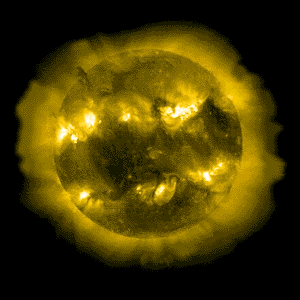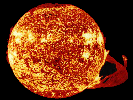S U N S T O R M SBy Luiza Becari
The X-ray Solar status monitor downloads data periodically from the NOAA
Space Environment Center FTP server. The previous 24
hours of 5 minute Long-wavelength x-ray data from each satellite (GOES 8
and GOES 10) is analyzed, and an appropriate level of
activity is assigned as follows:
Normal: Solar X-ray flux is quiet (< 1.00e-6 W/m^2)
In 1989, a large Sun Storm caused a massive blackout in the province of Quebec, Canada. It almost did the same on the East Coast of the United States. Most people have never heard of a Sun Storm, or Geomagnetic Storm. In fact, sun storms would remain largely unknown if their effects on our planet were not so devastating.
According to Richard Thompson, at the IPS Radio and Space Services in
Australia, these sun storms cause such extensive damage because of "the surges of electric current they induce in long conductors, such as power lines and pipelines".
A geomagnetic storm is the result of constant explosions on the searing surface of the Sun. These explosions throw off an incredible amount of highly energetic particles, which stream into space at velocities of thousands of miles an hour. When these particles happen to hit our atmosphere, the consequences may be drastic.  Unseen to the naked eye, these highly charged particles can cause any number of harmful consequences:
Cycles of Nature The Sun has periodic cycles of heightened activity. This is known as the "eleven year cycle." The 1989 storm happened during the last "solar maximum" (the strongest part of the eleven year cycle) and its effects were felt all over the world. The next peak is scheduled for the years 2000/2002 and it is expected to cause even more damages than the 1989 storm. Being prepared is the best way to avoid the effects of a Sun storm. The Space Program, for example, has to schedule its activities in a way to protect astronauts and safeguard spacecraft. Power companies, predicting a sun storm allows them to prepare their grids to stand the great interference caused by ionized particles coming from the Sun and to anticipate interruptions or even a total energy blackouts. Scientist have been working hard to find a predict and detect solar storms as soon as they start on their way to Earth. Unfortunately, forecasting these storms is not as simple as predicting the weather here on Earth. Forecasts for most Geomagnetic storm can only be made in very short advance. There is usually only "2 to 4 days warning, as the material moves outward from the Sun," says Richard Thompson. Although the possibility of a storm coming may be seen days in advance, the most reliable and precise forecasts can be given only about one hour before the storm hits. These immediate forecasts can be derived thanks to the solar wind information scientists only recently started receiving from the ACE spacecraft. The latest monitoring spacecraft is positioned between the Earth and the Sun (but much closer to Earth). Unfortunately, such a short notice does not give much time for concerned parties to get prepared. Because sun storm detection is so vital, scientists keep their eyes on the skies day and night, monitoring the Sun 24 hours a day, seven days a week. Some scientists have recently proposed a mathematical model that involves the rate of planetary axial revolution and the corresponding rates of revolution of solar currents at various latitudes. There is some suggestion that this theory can predict past solar storms, as well as future solar activity. Until this theory is confirmed and accepted by the scientific community, constant vigilance is the only reliable system for warning of these dangerous storms. Just In Time? The Cassini probe (see Cassini: A Poisonous Package in Viewzone archives) is scheduled to return to Earth's atmosphere on August, 16, 1999. This date coincides with the beginning of the next Solar Maximum. The probability of Sun storms will be the greatest since the last peak in 1989, when the blackout in Quebec occurred. What does this mean? Besides the expected risks Nasa took in launching its probe, filled with about 72 pounds of radioactive fuel, there is also the possibility of the probe suffering interference from geomagnetic storms and other effects derived from solar flares. A very unique alignment of the planets, called The Grand Cross, will also coincide with Cassini's return. Opinions on whether and how an accident with the probe and its poisonous contents would affect our planet diverge radically. But even those who dismiss any possibility of contamination admit there's a chance Cassini will break up if its "sling-shot" rendezvous is altered. The extent and gravity of the damages will only be completely understood when and if the accident happens. Unfortunately, it may be too late. Luiza Becari is a freelance writer and humanitarian residing in Brazil.
|

 Sun Storms are caused by changes in the space weather, which also cause ionospheric storms, bombardments of the Earth by charged particles and dramatic increases in dangerous radiation such as X-rays, gamma rays and more. Since the power outages of 1989, virtually every power plant, computer company and other service that is vulnerable to radiation interference, has been trying to find a way to avoid sun storm damage. Their success or failure could mean the safeguarding of millions-- or billions-- of dollars in damaged equipment and lost revenues.
Sun Storms are caused by changes in the space weather, which also cause ionospheric storms, bombardments of the Earth by charged particles and dramatic increases in dangerous radiation such as X-rays, gamma rays and more. Since the power outages of 1989, virtually every power plant, computer company and other service that is vulnerable to radiation interference, has been trying to find a way to avoid sun storm damage. Their success or failure could mean the safeguarding of millions-- or billions-- of dollars in damaged equipment and lost revenues.